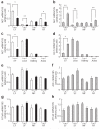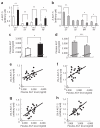Adipose tissue-specific regulation of angiotensinogen in obese humans and mice: impact of nutritional status and adipocyte hypertrophy
- PMID: 20057360
- PMCID: PMC2842463
- DOI: 10.1038/ajh.2009.263
Adipose tissue-specific regulation of angiotensinogen in obese humans and mice: impact of nutritional status and adipocyte hypertrophy
Abstract
Background: The adipose tissue renin-angiotensin system (RAS) has been implicated in the pathophysiology of obesity and dysfunction of adipose tissue. However, neither regulation of angiotensinogen (AGT) expression in adipose tissue nor secretion of adipose tissue-derived AGT has been fully elucidated in humans.
Methods: Human subcutaneous abdominal adipose tissue (SAT) biopsies were performed for 46 subjects with a wide range of body mass index (BMI). Considering the mRNA level of AGT and indices of body fat mass, the amount of adipose tissue-derived AGT secretion (A-AGT-S) was estimated. Using a mouse model of obesity and weight reduction, plasma AGT levels were measured with a newly developed enzyme-linked immunosorbent assay (ELISA), and the contribution of A-AGT-S to plasma AGT levels was assessed.
Results: A-AGT-S was substantially increased in obese humans and the value was correlated with the plasma AGT level in mice. A-AGT-S and plasma AGT were higher in obese mice, whereas lower in mice with weight reduction. However, the AGT mRNA levels in the liver, kidney, and aorta were not altered in the mouse models. In both humans and mice, the AGT mRNA levels in mature adipocytes (MAs) were comparable to those in stromal-vascular cells. Coulter Multisizer analyses revealed that AGT mRNA levels in the MAs were inversely correlated with the average size of mature adipocytes.
Conclusions: This study demonstrates that adipose tissue-derived AGT is substantially augmented in obese humans, which may contribute considerably to elevated levels of circulating AGT. Adipose tissue-specific regulation of AGT provides a novel insight into the clinical implications of adipose tissue RAS in human obesity.
Figures




Similar articles
-
Adipose tissue-specific dysregulation of angiotensinogen by oxidative stress in obesity.Metabolism. 2010 Sep;59(9):1241-51. doi: 10.1016/j.metabol.2009.11.016. Epub 2010 Jan 4. Metabolism. 2010. PMID: 20045538 Free PMC article.
-
Angiotensinogen gene expression in adipose tissue: analysis of obese models and hormonal and nutritional control.Am J Physiol. 1997 Jul;273(1 Pt 2):R236-42. doi: 10.1152/ajpregu.1997.273.1.R236. Am J Physiol. 1997. PMID: 9249555
-
Adipose tissue-specific increase in angiotensinogen expression and secretion in the obese (fa/fa) Zucker rat.Am J Physiol Endocrinol Metab. 2002 Jan;282(1):E59-66. doi: 10.1152/ajpendo.2002.282.1.E59. Am J Physiol Endocrinol Metab. 2002. PMID: 11739084
-
Angiotensinogen, angiotensin II and adipose tissue development.Int J Obes Relat Metab Disord. 2000 Nov;24 Suppl 4:S33-5. doi: 10.1038/sj.ijo.0801501. Int J Obes Relat Metab Disord. 2000. PMID: 11126238 Review.
-
Perivascular Adipose Tissue in Vascular Function: Does Locally Synthesized Angiotensinogen Play a Role?J Cardiovasc Pharmacol. 2021 Dec 1;78(Suppl 6):S53-S62. doi: 10.1097/FJC.0000000000001027. J Cardiovasc Pharmacol. 2021. PMID: 34840262 Review.
Cited by
-
Vitamin D3 therapy corrects the tissue sensitivity to angiotensin ii akin to the action of a converting enzyme inhibitor in obese hypertensives: an interventional study.J Clin Endocrinol Metab. 2012 Jul;97(7):2456-65. doi: 10.1210/jc.2012-1156. Epub 2012 Apr 26. J Clin Endocrinol Metab. 2012. PMID: 22539586 Free PMC article. Clinical Trial.
-
The peptide network regulated by angiotensin converting enzyme (ACE) in hematopoiesis.Cell Cycle. 2011 May 1;10(9):1363-9. doi: 10.4161/cc.10.9.15444. Epub 2011 May 1. Cell Cycle. 2011. PMID: 21441775 Free PMC article. Review.
-
Structure and functions of angiotensinogen.Hypertens Res. 2016 Jul;39(7):492-500. doi: 10.1038/hr.2016.17. Epub 2016 Feb 18. Hypertens Res. 2016. PMID: 26888118 Free PMC article. Review.
-
The transcriptional regulation of the human angiotensinogen gene after high-fat diet is haplotype-dependent: Novel insights into the gene-regulatory networks and implications for human hypertension.PLoS One. 2017 May 3;12(5):e0176373. doi: 10.1371/journal.pone.0176373. eCollection 2017. PLoS One. 2017. PMID: 28467442 Free PMC article.
-
Urinary angiotensinogen is correlated with blood pressure in men (Bogalusa Heart Study).J Hypertens. 2010 Jul;28(7):1422-8. doi: 10.1097/HJH.0b013e3283392673. J Hypertens. 2010. PMID: 20375906 Free PMC article.
References
-
- Engeli S, Schling P, Gorzelniak K, Boschmann M, Janke J, Ailhaud G, Teboul M, Massiéra F, Sharma AM. The adipose-tissue renin-angiotensin-aldosterone system: role in the metabolic syndrome? Int J Biochem Cell Biol. 2002;35:807–825. - PubMed
-
- Dzau VJ. Circulating versus local renin-angiotensin system in cardiovascular homeostasis. Circulation. 1988;77:4–13. - PubMed
-
- Kurtz TW. Beyond the classic angiotensin-receptor-blocker profile. Nat Clin Pract Cardiovasc Med. 2008;5(Suppl 1):S19–S26. - PubMed
-
- Yusuf S, Sleight P, Pogue J, Bosch J, Davies R, Dagenais G, The Heart Outcomes Prevention Evaluation Study Investigators Effects of an angiotensin-converting-enzyme inhibitor, ramipril, on cardiovascular events in high-risk patients. N Engl J Med. 2000;20:145–153. - PubMed
-
- Ogihara T, Nakao K, Fukui T, Fukiyama K, Saruta T. Clinical outcomes in hypertensive patients with high cardiovascular risks: principal results of candesartan antihypertensive survival evaluation in Japan (CASE-J) study; The 21st Scientific Meeting of the International Society of Hypertension; Fukuoka, Japan. 2006.
Publication types
MeSH terms
Substances
Grants and funding
LinkOut - more resources
Full Text Sources
Medical
Research Materials
Miscellaneous

